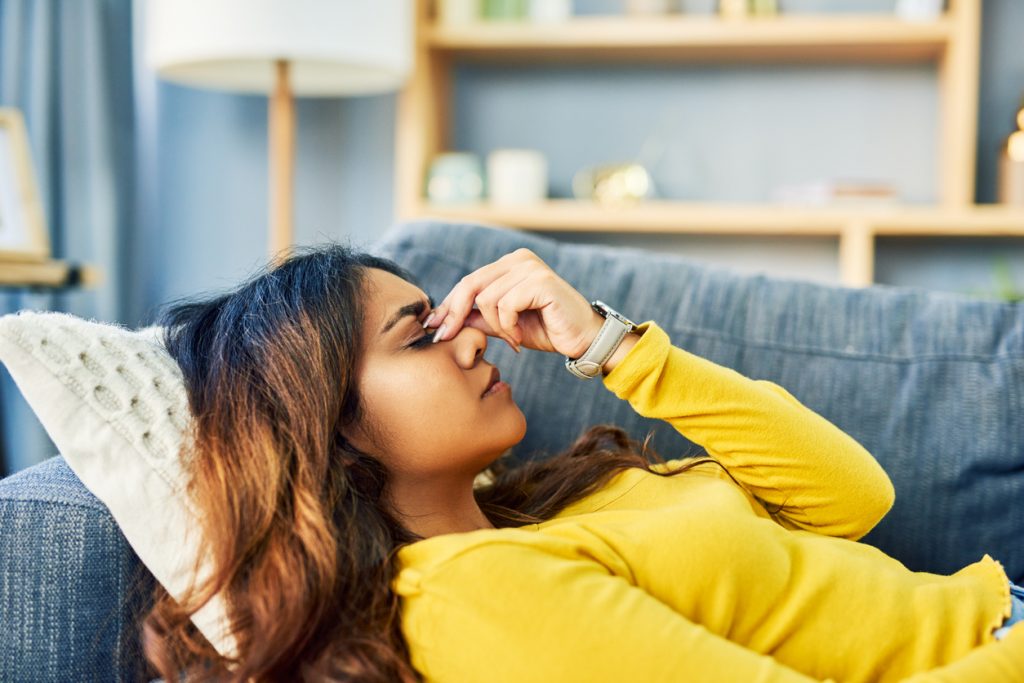A quick guide to migraine: symptoms, causes and treatment
Around 1 in 5 Australians will experience a migraine episode at some point in their lives.
Migraine is not simply bad headaches. Migraine symptoms can cause massive disruptions to life, and can prevent or reduce participation in work, school or family activities.

What is a migraine episode?
Migraine is a neurological condition that is sometimes very distressing and disabling. Some of the common migraine symptoms may include:
- A bad headache that’s both painful and throbbing, often on one side of the head (but can be both sides)
- Nausea and vomiting
- Difficulty speaking
- Sensitivity to light, sound and even smells
- Numbness and tingling
Migraine symptoms can last from around 4 hours to up to 3 days.
Migraine can be divided into 5 distinct phases: prodromol (early warning signs), aura, headache, resolution and postdromol (recovery). Let’s take a look at the features of these phases:
1. Prodromol phase – early warning signs of migraine
Some people experience early warning signs of a migraine attack. This is called the prodromal phase and can include:
- Mood changes, which can be either high (like feeling elated, on top of the world and full of energy) or low (feeling depressed and cranky)
- Increased or decreased appetite
- Other gut problems like nausea, constipation or diarrhoea
- Drowsiness, incessant yawning or trouble speaking
- Sensitivity to light and sound, or difficulty with visual focus
2. Migraine aura phase
Around 20-30% of people experience visual disturbances before a migraine episode. This is known as aura. People with migraine have described aura as:
- Bright zigzag lines
- Flashing lights
- Difficulty focusing
- Blind spots.
Normal vision usually comes back after the aura phase, or after the headache phase.

3. Headache phase
This is the phase most commonly associated with a migraine episode.
The head pain is often pulsing and located on one side of the head (but can affect both sides). Movement usually makes the pain worse.
Often, it’s the accompanying symptoms that are most distressing and limiting. These include nausea and vomiting, as well as sensitivity to light, sound and smell.
4. Resolution phase
Often, a migraine episode ends during sleep. Sometimes people feel better after vomiting, especially children. For others, effective migraine treatment can provide relief or conclude the current attack.
For a few people, intervention is not helpful, and they just need to wait for the headache to ‘burn out’.
5. Postdromol phase (recovery)
Most people feel relieved once the headache and nausea have passed. But some people report feeling drained for about 24 hours afterward. Other people report feeling energetic and alive.
Migraine causes: what’s the latest?
Clinical researchers have not yet agreed on what causes migraine. The best theory found from recent research suggests:
- Migraine episodes are caused by an interplay between your brain cells and the blood vessels in your brain.
- Certain parts of the brain seem to become super sensitised before and during migraine episodes. These parts overreact to sensations such as emotion or sudden changes to the environment.
- The pain centre of the trigeminal nerve (a nerve within your neck and head) can activate, causing pain in the head or upper neck.
It’s unclear why these processes happen to some people and not others. One common risk factor is a family history of migraine.
Migraine episodes also tend to be more common in women than men. And both children and adults can experience them.
Common migraine triggers
There are a variety of triggers that can cause a migraine episode, but some of the common ones include:
- Hormonal changes (high oestrogen levels) and the oral contraceptive pill for women
- Overstimulation of your senses (flashing lights, strong smells or noisy environments)
- Stress and changes of routine
- Too little sleep
- Dehydration
- Intense physical activity
- Changes in the weather (some people experience migraines caused by thunderstorms)
- Alcoholic drinks (especially red wine and beer)
- Cheese, chocolate, red wine and monosodium glutamate (MSG)
- Hunger, especially from skipping meals.

How to get rid of a migraine episode
If you think you have—or have had—a migraine episode, you should talk to a doctor. A doctor will want to ask you some questions about your migraine symptoms. They may recommend certain tests to investigate other potential health problems that could be causing your migraines.
If you’ve been diagnosed with migraine before and your symptoms change, you should speak to a doctor. If you start having more frequent migraine episodes you should also speak to a doctor.
You can also try these natural migraine relief strategies to help ease the pain:
- Lie down in a quiet, dark room
- Massage your scalp or temples
- Place a cold cloth over your forehead or behind your neck
How to prevent migraine
While it’s impossible to control all potential migraine causes and triggers, you can make some intentional changes to your lifestyle that may be beneficial:
- Manage stress: use relaxation techniques like mindfulness and breathing to settle overactive nerves. If you find you are stressed a lot, speak with a doctor.
- Exercise: making sure you begin with gentle activity, building up slowly. Intense exercise can cause migraine. Exercise can also help manage stress.
- Get good quality sleep
- Hydrate well: men should drink about 13 cups of fluids and women should drink 9 cups each day.
- Avoid skipping meals
- Quit smoking
Some people who are prone to migraine also find it useful to keep a headache diary. This can help you and your doctor identify migraine causes. A diary can also help work out the best type of migraine treatment for you.
To speak with an InstantScripts Doctor:
Request a ConsultationIf you have run out of your script:
Request a Script© InstantScripts
Level 8 / 637 Flinders St.,
Docklands VIC 3008

